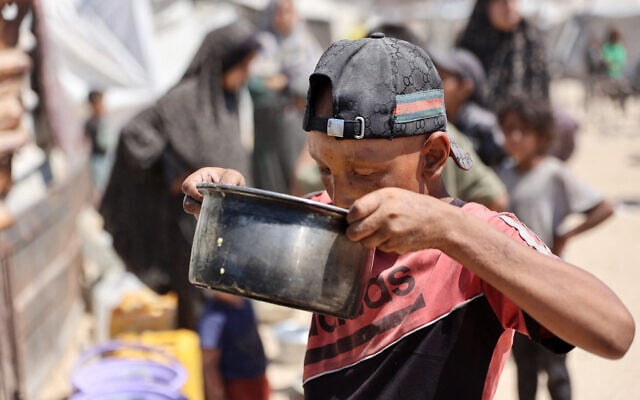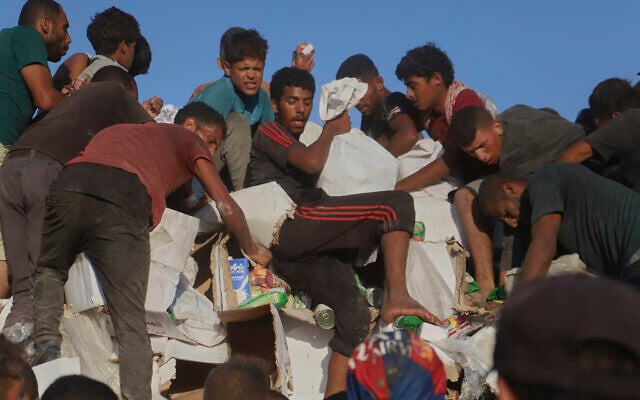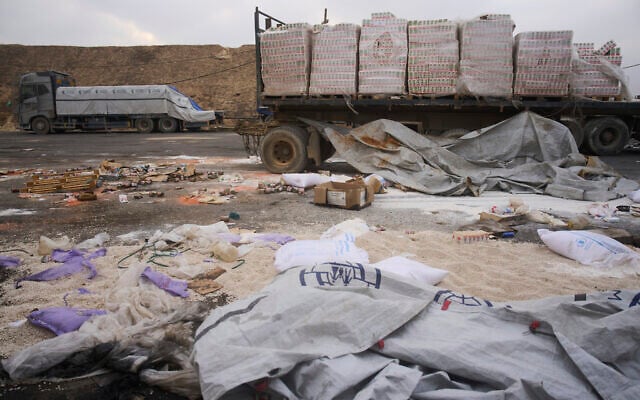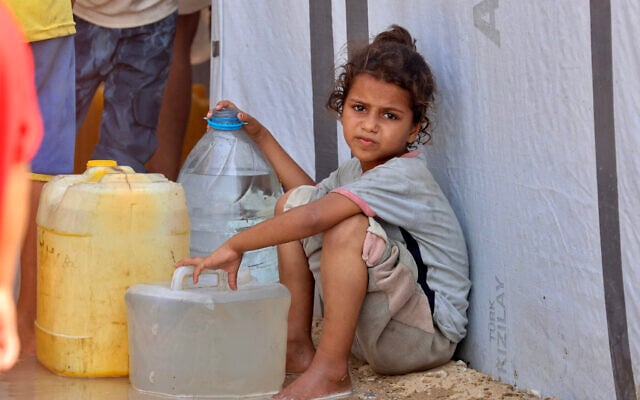



Close to 13,000 children were admitted to treatment centers in Gaza due to acute malnutrition in July amid severe food shortages, the UN Office for the Coordination of Humanitarian Affairs said in a periodic update on the situation in the war-torn Gaza Strip.
The update released Wednesday painted a dire picture for the children of the Strip, with increased cases of acute malnutrition and hospitalizations putting the enclave’s overburdened and tattered healthcare system under even more strain.
According to OCHA, the total number of severe acute malnutrition cases diagnosed in children in July rose to 2,800, or roughly 22 percent of all childhood malnutrition cases diagnosed last month.
While in most cases, acute malnutrition can be treated at any of the 106 outpatient sites dedicated to it across the Gaza Strip, OCHA said cases in which hospitalization is required have become increasingly challenging.
In total, 129 cases of severe acute malnutrition with complications that required hospitalization were diagnosed in July. This marked a sharp uptick in cases, as between the months of January to June, there were just 215 cases requiring hospitalization.
Despite the rising demand, there are still only five sites across the entire Gaza Strip at which children with complications of severe acute malnutrition can be stabilized and treated, OCHA said. Two of the stabilization sites are located in Gaza City, one is in Deir al-Balah, and the final two are located in Khan Younis.
In total, there are only 43 beds available across the five combined sites.
The report did not confirm the ages of the children diagnosed with malnutrition over the past month.
Gaza’s Hamas-run health ministry has said that 42 children have died of malnutrition-related causes since July 1, along with 129 adults, although those numbers could not be independently verified.
Widening its purview to examine the state of the humanitarian conditions across the entire Strip, the OCHA report painted a bleak picture.
It said that while the UN’s World Food Programme collected 1,012 trucks carrying 13,000 metric tons of food from Gaza’s border crossings in July, only 10 of them ever reached their intended warehouses once inside the Strip.
The remainder were “offloaded en route,” it said, although it was unclear whether this was referring to organized theft or to looting by crowds of hungry civilians.
In theory, OCHA said, the Food Security Sector believes there is enough food in or en route to Gaza to feed the population of roughly 2.1 million people for the next three months. But in reality, “the risk of spoilage and infestation of the stranded food supplies has significantly increased, and some of them are reaching their expiry dates.”
It said that FSS was calling for “large-scale humanitarian assistance with guaranteed safe, unimpeded and sustained access” to ensure that the full amount of food earmarked for Gaza truly reaches its intended destination.
Images of starving Gazans drew international outrage last month and heaped pressure on Israel until, on July 27, it announced measures to allow more aid into the Gaza Strip.
But aid agencies have warned that the slightly eased measures — including restarting the practice of airdropping supplies into Gaza — are not enough to fill the gap created by long months of little to no aid entering the enclave, and that on top of that, only a fraction of what is sent ends up entering the Strip.
Israel strongly denies limiting aid supplies and accuses Hamas of exploiting deliveries to boost its military capabilities.
On Thursday, dozens of aid groups signed a statement alleging that Israel was refusing to let a number of international NGOs distribute aid in Gaza, leaving millions of dollars’ worth of food and other assistance sitting in warehouses and putting future aid operations at risk.
Separately, the Haaretz newspaper reported that massive amounts of humanitarian aid have been spilling off trucks in Gaza and going to waste because the IDF is not allowing organizations to properly secure the cargo.
According to the report, Israeli soldiers at the Kerem Shalom Crossing rush aid workers to quickly load cargo onto trucks that are regularly delayed for hours at a time. Because the food isn’t tied down well and aid seekers are not given ample time to identify the route being used, aid has become easy to loot when the trucks reach areas where civilians are waiting.
The poorly secured aid also leads to large amounts of it spilling over, as the roads used by aid groups have been badly damaged by the war.
Even satellite images can show long trails of flour extending from the Kerem Shalom Crossing.
COGAT, the Defense Ministry body that coordinates aid, said in response to the signed statement from aid workers that Israel invests “considerable efforts” in aid distribution, and does not place “any quantitative limit” on the number of trucks entering the Gaza Strip.
The agency did not address specific questions about aid shipment volumes, nor did it address Haaretz’s claim regarding Israeli restrictions on properly fastening aid to trucks.
But even with large amounts of aid failing to reach their intended destination, and the dire warnings that the aid is falling far short of what is needed, the impact of the eased regulations could be felt in the Strip, OCHA said, as “different types of food have started to trickle into the markets.”
As a result, the eased restrictions have lowered the price of some basic ingredients, it said, with the price of sugar dropping to NIS 30-40 ($9-12) per kilogram as of August 10, down from a peak price of NIS 600 ($180) per kilogram earlier this year.
And it wasn’t just ingredients that were becoming more available for Gaza’s civilians — the amount of hot meals prepared by humanitarian groups was increasing too, OCHA said.
It said that as of August 10, 324,000 meals were being prepared each day at 81 community kitchens across the Gaza Strip, up from 259,000 two weeks earlier.
Of that number, around 99,000 are distributed to people in the north of the Strip, and 225,000 to those in the center and south.
While trending in the right direction, OCHA reiterated that those numbers fall far short of the roughly one million meals that were distributed across the Strip daily back in April.
“People continue to suffer from extremely imbalanced diets that lack essential nutrients, increasing the risk of acute malnutrition,” it cautioned.
Accessing humanitarian aid in the Strip continues to be dangerous, even though the quantity has somewhat increased in recent weeks, with near-daily reports of mass-casualty incidents near aid sites persisting.
On Thursday, a spokesman for Gaza’s Hamas-run civil defense agency said six people had been killed while waiting for humanitarian aid.
While the spokesman did not say whether the alleged incident occurred near an aid truck or at a designated aid distribution site, the majority of such incidents have been reported to occur near aid sites run by the US- and Israel-backed Gaza Humanitarian Foundation.
The United Nations says more than 1,300 people have been killed trying to obtain aid supplies in the enclave since the GHF began operating in May, most of them shot by Israeli forces operating near GHF sites.
Israel does not often comment on individual reports of shootings near aid sites, but the IDF has acknowledged in the past that it fires warning shots at crowds that get too close to its soldiers. Israel has also said the UN tallies exaggerated, though it hasn’t provided alternative casualty figures.
Agencies contributed to this report.




